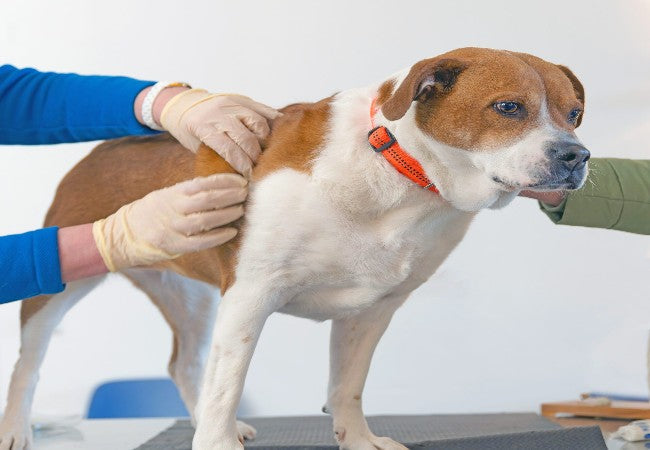Skin Tags in Dogs 2025: Vet Reviewed Guide to Recognition, Care & Removal 🐾

In this article
Skin Tags in Dogs 2025: Vet Reviewed Guide to Recognition, Care & Removal 🐾
By Dr. Duncan Houston BVSc
Skin tags—also called fibrovascular papillomas or acrochordons—are small, benign growths that commonly affect dogs, especially older or larger breeds. While generally harmless, it’s important to understand their nature, recognize when removal or veterinary attention is needed, and learn how to manage them with confidence.
1. 🧬 What Are Skin Tags?
Skin tags are overgrowths of connective tissue—collagen and blood vessels—often on a narrow stalk. Soft or firm, stalked or flat, they range from millimeters to several centimeters and usually match your dog’s skin color.
2. 🍂 Common Locations & At‑Risk Dogs
- Areas exposed to friction: armpits, groin, neck under collars, chest, elbows, abdomen.
- Breeds & ages: large breeds and older dogs (Boxers, Poodles, Cocker Spaniels, Schnauzers) are predisposed.
3. ⚠️ Causes & Triggers
- Friction or trauma: from collars, harnesses, skin folds, and grooming mats.
- Age & genetics: skin elasticity decreases over time, allowing tags to form; genetics play a role.
- Viral: sometimes due to papilloma virus—though less common than wart-like papillomas.
4. 🔍 Differentiating Skin Tags from Other Lumps
- Warts (papillomas): cauliflower‑like surface, viral, often in younger dogs; can regress.
- Ticks: darker, firm, embedded, may move and engorge.
- Other tumors: sebaceous gland tumors, histiocytomas, mast cell tumors may resemble tags—especially if atypical.
5. 🩺 Diagnosis: When Vet Evaluation Is Needed
- Physical exam: vets can usually identify tags by appearance and palpation.
- Biopsy or cytology: recommended for irregular, fast-growing, ulcerated, pigmented or bleeding lesions.
- Further testing: bloodwork or imaging in suspicious cases, especially for large growths.
6. ⚕️ Treatment Options
- Monitor: small, non-irritated tags often require no treatment.
- Surgical removal: excise or cauterize during other procedures or standalone.
- Cryotherapy: freezing off with liquid nitrogen—multiple sessions may be needed.
- Electrocautery: burns off the tag with heat under local anesthesia.
- Ligation: tying off stalks to let tags fall off naturally.
- Antivirals: for papilloma-caused tag clusters.
7. 🛡️ Post‑Removal Care & Healing
- Use an E‑collar or prevent chewing to protect the healing area.
- If redness, oozing, or unusual signs appear, consult via **Ask A Vet** promptly.
8. 🧼 Prevention Strategies
- Choose well-fitted, padded collars and harnesses to minimize friction.
- Provide soft, supportive bedding to reduce pressure on elbows or chest.
- Keep skin folds clean and dry using gentle products like MalAcetic wipes.
- Manage allergies that cause scratching.
- Regularly check skin for new growths and schedule vet visits for concerning lumps.
9. 📊 When to Worry: Red Flags
- Rapid growth, ulceration, swelling, bleeding, or discharge.
- Dark pigmentation changes or irregular shapes.
- New tags in unusual areas or clusters could indicate papilloma or tumors.
10. 🐕 Breed & Age-Specific Guidance
| Breed/Age Group | Tag Risk | Care Tips |
|---|---|---|
| Large breeds & seniors | High risk from friction and age | Inspect and clean elbows, chest; use soft bedding |
| Wrinkled breeds (Pugs, Bulldogs) | Tags in folds | Daily fold cleaning and drying; soft collars |
| Active collars/harness dogs | Neck/shoulder tags | Rotate collars; use padded harnesses |
| Allergy‑prone dogs | Biting-related tags | Treat allergies; use gentle skin soothers |
11. 📌 Key Takeaways for Dog Parents
- Skin tags are benign, common, and rarely require treatment unless irritated.
- Differentiate tags from warts, ticks, or tumors through appearance and vet evaluation.
- Removal is available through several safe veterinary methods.
- Prevention focuses on reducing skin friction and managing skin health.
- Monitor for red flags—consult vet or Ask A Vet if you’re unsure.






